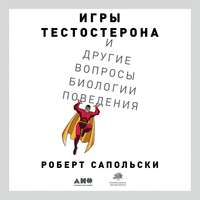
Полная версия
Биология добра и зла. Как наука объясняет наши поступки
12
Небольшая и обескураживающая литература касается молодых солдат и пострадавших при геноциде, которые смогли преодолеть симптомы посттравматических расстройств с помощью жестокого поведения: R. Weierstall et al., “When Combat Prevents PTSD Symptoms: Results from a Survey with Former Child Soldiers in Northern Uganda,” BMC, Psychiatry 12 (2012): 41; R. Weierstall et al., “The Thrill of Being Violent as an Antidote to Posttraumatic Stress Disorder in Rwandese Genocide Perpetrators,” Eur J Psychotraumatology 2 (2011): 6345; V. Nell, “Cruelty’s Rewards: The Gratifications of Perpetrators and Spectators,” BBS 29 (2006): 211; T. Elbert et al., “Fascination Violence: On Mind and Brain of Man Hunters,” Eur Arch Psychiatry and Clin Nsci 260 (2010): S100.
13
B. Oakley et al., Pathological Altruism (Oxford: Oxford University Press, 2011).
14
L. MacFarquhar, “The Kindest Cut,” New Yorker, July 27, 2009, p. 38.
15
К сноске: For a lengthy overview of Munchausen syndrome by proxy, see R. Sapolsky, “Nursery Crimes,” in Monkeyluv and Other Essays on Our Lives as Animals (New York: Simon and Schuster /Scribner, 2005).
16
J. King et al., “Doing the Right Thing: A Common Neural Circuit for Appropriate Violent or Compassion Behavior,” NeuroImage 30 (2006): 1069.
17
Обзор открытий и размышлений Маклина можно найти в работе: P. MacLean, The Triune Brain in Evolution (New York: Springer, 1990).
18
A. Damasio, Descartes’ Error: Emotion, Reason, and the Human Brain (New York: Putnam, 1994; Penguin, 2005).
19
W. Nauta, “The Problem of the Frontal Lobe: A Reinterpretation,” J Psychiatric Res 8 (1971): 167; W. Nauta and M. Feirtag, “The Organization of the Brain,” Sci Am 241 (1979): 88.
20
R. Nelson and B. Trainor, “Neural Mechanisms of Aggression,” Nat Rev Nsci 8 (2007): 536.
21
Другие следствия повреждения миндалины у человека изложены в работах: A. Young et al., “Face Processing Impairments After Amygdalotomy,” Brain 118 (1995): 15; H. Narabayashi et al., “Stereotaxic Amygdalotomy for Behavior Disorders,” Arch Neurol 9 (1963): 1; V. Balasubramaniam and T. Kanaka, “Amygdalotomy and Hypothalamotomy: A Comparative Study,” Confinia Neurologia 37 (1975): 195; R. Heimburger et al., “Stereotaxic Amygdalotomy for Epilepsy with Aggressive Behavior,” JAMA 198 (1966): 741; B. Ramamurthi, “Stereotactic Operation in Behavior Disorders: Amygdalotomy and Hypothalamotomy,” Acta Neurochirurgica (Wien) 44 (1988): 152; G. Lee et al., “Clinical and Physiological Effects of Stereotaxic Bilateral Amygdalotomy for Intractable Aggression,” J.Neuropsychiatry and Clin Nsci 10 (1998): 413; E. Hitchcock and V. Cairns, “Amygdalotomy,” Postgraduate Med J.49 (1973): 894 и M. Mpakopoulou et al., “Stereotactic Amygdalotomy in the Management of Severe Aggressive Behavioral Disorders,” Neurosurgical Focus 25 (2008): E6.
22
Вот некоторые статьи, касающиеся политических споров вокруг хирургического удаления миндалины: V. Mark et al., “Role of Brain Disease in Riots and Urban Violence,” JAMA 201 (1967): 217; P. Breggin, “Psychosurgery for Political Purposes,” Duquesne Law Rev 13 (1975): 841; E. Valenstein, Great and Desperate Cures: The Rise and Decline of Psychosurgery and Other Radical Treatments for Mental Illness (New York: Basic Books 2010).
23
C. Holden, “Fuss over a Terrorist’s Brain,” Sci 298 (2002): 1551
24
D. Eagleman, “The Brain on Trial,” Atlantic, June 7, 2011; G. Lavergne, A Sniper in the Tower (Denton: University of North Texas Press, 1997); H. Hylton, “Texas Sniper’s Brother John Whitman Shot,” Palm Beach Post, July 5, 1973, p. A1.
25
Великолепный обзор роли агрессии в формировании страха: J. LeDoux, The Emotional Brain: The Mysterious Underpinnings of Emotional Life (New York: Simon and Schuster, 1998).
26
N. Kalin et al., “The Role of the Central Nucleus of the Amygdala in Mediating Fear and Anxiety in the Primate,” J Nsci 24 (2004): 5506; T. Hare et al., “Contributions of Amygdala and Striatal Activity in Emotion Regulation,” BP 57 (2005): 624; D. Zald, “The Human Amygdala and the Emotional Evaluation of Sensory Stimuli,” Brain Res Rev 41 (2003): 88.
27
D. Mobbs et al., “When Fear Is Near: Threat Imminence Elicits Prefrontal-Periaqueductal Gray Shifts in Humans,” Sci 317 (2007): 1079.
28
G. Berns, “Neurobiological Substrates of Dread,” Sci 312 (2006): 754. Также о роли миндалины в реакции испуга у человека можно прочитать в следующих статьях: R. Adolphs et al., “Impaired Recognition of Emotion in Facial Expressions Following Bilateral Damage to the Human Amygdala,” Nat 372 (1994): 669; A. Young et al., “Face Processing Impairments After Amygdalotomy,” Brain 118 (1995): 15; J. Feinstein et al., “The Human Amygdala and the Induction and Experience of Fear,” Curr Biol 21 (2011): 34; A. Bechara et al., “Double Dissociation of Conditioning and Declarative Knowledge Relative to the Amygdala and Hippocampus in Humans,” Sci 269 (1995): 1115.
29
A. Gilboa et al., “Functional Connectivity of the Prefrontal Cortex and the Amygdala in PTSD,” BP 55 (2004): 263.
30
M. Hsu et al., “Neural Systems Responding to Degrees of Uncertainty in Human Decision-Making,” Sci 310 (2006): 1680; J. Rilling et al., “The Neural Correlates of Mate Competition in Dominant Male Rhesus Macaques,” BP 56 (2004): 364.
31
C. Zink et al., “Know Your Place: Neural Processing of Social Hierarchy in Humans,” Neuron 58 (2008): 273; M. Freitas-Ferrari et al., “Neuroimaging in Social Anxiety Disorder: A Systematic Review of the Literature,” Prog Neuro-Psychopharmacology and Biol Psychiatry 34 (2010): 565.
32
G. Berns et al., “Neurobiological Correlates of Social Conformity and Independence During Mental Rotation,” BP 58 (2005): 245.
33
K. Tye et al., “Amygdala Circuitry Mediating Reversible and Bidirectional Control of Anxiety,” Nat 471 (2011): 358; S. Kim et al., “Differing Neural Pathways Assemble a Behavioural State from Separable Features in Anxiety,” Nat 496 (2013): 219.
34
J. Ipser et al., “Meta-analysis of Functional Brain Imaging in Specific Phobia,” Psychiatry and Clin Nsci 67 (2013): 311; U. Lueken, “Neural Substrates of Defensive Reactivity in Two Subtypes of Specific Phobia,” SCAN 9 (2013): 11; A. Del Casale et al., “Functional Neuroimaging in Specific Phobia,” Psychiatry Res 202 (2012): 181; J. Feinstein et al., “Fear and Panic in Humans with Bilateral Amygdala Damage,” Nat Nsci 16 (2013): 270.
35
M. Cook and S. Mineka, “Selective Associations in the Observational Conditioning of Fear in Rhesus Monkeys,” J Exp Psych and Animal Behav Processes 16 (1990): 372; S. Mineka and M. Cook, “Immunization Against the Observational Conditioning of Snake Fear in Rhesus Monkeys,” J Abnormal Psych 95 (1986): 307.
36
S. Rodrigues et al., “Molecular Mechanisms Underlying Emotional Learning and Memory in the Lateral Amygdala,” Neuron 44 (2004): 75; J. Johansen et al., “Optical Activation of Lateral Amygdala Pyramidal Cells Instructs Associative Fear Learning,” PNAS 107 (2010): 12692; S. Rodrigues et al., “The Influence of Stress Hormones on Fear Circuitry,” Ann Rev of Nsci, 32 (2009): 289; S. Rumpel et al., “Postsynaptic Receptor Trafficking Underlying a Form of Associative Learning,” Sci 308 (2005): 83. Другие работы в этой области: C. Herry et al., “Switching On and Off Fear by Distinct Neuronal Circuits,” Nat 454 (2008): 600; S. Maren and G. Quirk, “Neuronal Signaling of Fear Memory,” Nat Rev Nsci 5 (2004): 844; S. Wolff et al., “Amygdala Interneuron Subtypes Control Fear Learning Through Disinhibition,” Nat 509 (2014): 453; R. LaLumiere, “Optogenetic Dissection of Amygdala Functioning,” Front Behav Nsci 8 (2014): 1.
37
T. Amano et al., “Synaptic Correlates of Fear Extinction in the Amygdala,” Nat Nsci 13 (2010): 489; M. Milad and G. Quirk, “Neurons in Medial Prefrontal Cortex Signal Memory for Fear Extinction,” Nat 420 (2002): 70; E. Phelps et al., “Extinction Learning in Humans: Role of the Amygdala and vmPFC,” Neuron 43 (2004): 897; S. Ciocchi et al., “Encoding of Conditioned Fear in Central Amygdala Inhibitory Circuits,” Nat 468 (2010): 277; W. Haubensak et al., “Genetic Dissection of an Amygdala Microcircuit That Gates Conditioned Fear,” Nat 468 (2010): 270.
38
K. Gospic et al., “Limbic Justice: Amygdala Involvement in Immediate Rejections in the Ultimatum Game,” PLoS ONE 9 (2011): e1001054; B. De Martino et al., “Frames, Biases, and Rational Decision-Making in the Human Brain,” Sci 313 (2006): 684; A. Bechara et al., “Role of the Amygdala in Decision-Making,” ANYAS 985 (2003): 356; B. De Martino et al., “Amygdala Damage Eliminates Monetary Loss Aversion,” PNAS 107 (2010): 3788; J. Van Honk et al., “Generous Economic Investments After Basolateral Amygdala Damage,” PNAS 110 (2013): 2506.
39
R. Adolphs et al., “The Human Amygdala in Social Judgment,” Nat 393 (1998): 470.
40
D. Zald, “The Human Amygdala and the Emotional Evaluation of Sensory Stimuli,” Brain Res Rev 41 (2003): 88; C. Saper, “Animal Behavior: The Nexus of Sex and Violence,” Nat 470 (2011): 179; D. Lin et al., “Functional Identification of an Aggression Locus in Mouse Hypothalamus,” Nat 470 (2011): 221; M. Baxter and E. Murray, “The Amygdala and Reward,” Nat Rev Nsci 3 (2002): 563. А вот другая область исследований – об активирующих миндалину положительных стимулах: S. Aalto et al., “Neuroanatomical Substrate of amusement and Sadness: A PET Activation Study Using Film Stimuli,” Neuroreport 13 (2002): 67–73; T. Uwano et al., “Neuronal Responsiveness to Various Sensory Stimuli, and Associative Learning in the Rat Amygdala,” Nsci 68 (1995): 339; K. Tye and P. Janak, “Amygdala Neurons Differentially Encode Motivation and Reinforcement,” J Nsci 27 (2007): 3937; G. Schoenbaum et al., “Orbitofrontal Cortex and Basolateral Amygdala Encode Expected Outcomes During Learning,” Nat Nsci 1 (1998): 155; I. Aharon et al., “Beautiful Faces Have Variable Reward Value: fMRI and Behavioral Evidence,” Neuron 32 (2001): 537.
41
P. Janak and K. Tye, “From Circuits to Behavior in the Amygdala,” Nat 517 (2015): 284.
42
J. LeDoux, “Coming to Terms with Fear,” PNAS 111 (2014): 2871; J. LeDoux, “The Amygdala,” Curr Biol 17 (2007): R868; K. Tully et al., “Norepinephrine Enables the Induction of Associative LTP at Thalamo-Amygdala Synapses,” PNAS 104 (2007): 14146.
43
T. Rizvi et al., “Connections Between the Central Nucleus of the Amygdala and the Midbrain Periaqueductal Gray: Topography and Reciprocity,” J Comp Neurol 303 (1991): 121; E. Kim et al., “Dorsal Periaqueductal Gray-Amygdala Pathway Conveys Both Innate and Learned Fear Responses in Rats,” PNAS 110 (2013): 14795; C.Del-Ben and F. Graeff, “Panic Disorder: Is the PAG Involved?” Neural Plasticity 2009 (2009): 108135; P. Petrovic et al., “Context Dependent Amygdala Deactivation During Pain,” Neuroimage 13 (2001): S457; J. Johnson et al., “Neural Substrates for Expectation-Modulated Fear Learning in the Amygdala and Periaqueductal Gray,” Nat Nsci 13 (2010): 979; W. Yoshida et al., “Uncertainty Increases Pain: Evidence for a Novel Mechanism of Pain Modulation Involving the Periaqueductal Gray,” J Nsci 33 (2013): 5638.
44
T. Heatherton, “Neuroscience of Self and Self-Regulation,” Ann Rev of Psych 62 (2011): 363; K. Krendl et al., “The Good, the Bad, and the Ugly: An fMRI Investigation of the Functional Anatomic Correlates of Stigma,” Soc Nsci 1 (2006): 5; F. Sambataro et al., “Preferential Responses in Amygdala and Insula During Presentation of Facial Contempt and Disgust,” Eur J Nsci 24, (2006): 2355.
45
X. Liu et al., “Optogenetic Stimulation of a Hippocampal Engram Activates Fear Memory Recall,” Nat 484 (2012): 381; T. Seidenbecher et al., “Amygdalar and Hippocampal Theta Rhythm Synchronization During Fear Memory Retrieval,” Sci 301 (2003): 846; R. Redondo et al., “Bidirectional Switch of the Valence Associated with a Hippocampal Contextual Memory Engram,” Nat 513 (2014): 426; E. Kirby et al., “Basolateral Amygdala Regulation of Adult Hippocampal Neurogenesis and Fear-Related Activation of Newborn Neurons,” Mol Psychiatry 17 (2012): 527.
46
A. Gozzi, “A Neural Switch for Active and Passive Fear,” Neuron 67 (2010): 656.
47
G. Aston-Jones and J. Cohen, “Adaptive Gain and the Role of the Locus Coeruleus-Norepinephrine System in Optimal Performance,” J Comp Neurol 493 (2005): 99; M. Carter et al., “Tuning Arousal with Optogenetic Modulation of Locus Coeruleus Neurons,”Nat Nsci 13 (2010): 1526.
48
D. Blanchard et al., “Lesions of Structures Showing FOS Expression to Cat Presentation: Effects on Responsivity to a Cat, Cat Odor, and Nonpredator Threat,” Nsci Biobehav Rev 29 (2005): 1243.
49
G. Holstege, “Brain Activation During Human Male Ejaculation,” J Nsci 23 (2003): 9185; H. Lee et al., “Scalable Control of Mounting and Attack by Ers1+ Neurons in the Ventromedial Hypothalamus,” Nat 509 (2014): 627; D. Anderson, “Optogenetics, Sex, and Violence in the Brain: Implications for Psychiatry,” BP 71 (2012): 1081.
50
K Blair, “Neuroimaging of Psychopathy and Antisocial Behavior: A Targeted Review,” Curr Psychiatry Rep 12 (2010): 76; K. Kiehl, The Psychopath Whisperer: The Nature of Those Without Conscience (Woodland Hills, CA: Crown Books, 2014); M. Koenigs et al., “Investigating the Neural Correlates of Psychopathy: A Critical Review,” Mol Psychiatry 16 (2011): 792.
51
Здесь весьма интересные рассуждения об импульсивности лобной коры: J. Dalley et al., “Impulsivity, Compulsivity, and Top-Down Cognitive Control,” Neuron 69 (2011): 680.
52
J. Rilling and T. Insel, “The Primate Neocortex in Comparative Perspective Using MRI,” J Hum Evol 37 (1999): 191; R. Barton and C. Venditti, “Human Frontal Lobes Are Not Relatively Large,” PNAS 110 (2013): 9001; Y. Zhang et al., “Accelerated Recruitment of New Brain Development Genes into the Human Genome,” PLoS Biol 9 (2011): e1001179; G. Miller, “New Clues About What Makes the Human Brain Special,” Sci 330 (2010): 1167; K. Semendeferi et al., “Humans and Great Apes Share a Large Frontal Cortex,” Nat Nsci 5 (2002): 272; P. Schoenemann, “Evolution of the Size and Functional Areas of the Human Brain,” Ann Rev of Anthropology 35 (2006): 379.
53
J. Allman et al., “The von Economo Neurons in the Frontoinsular and Anterior Cingulate Cortex,” ANYAS 1225 (2011): 59; C. Butti et al., “Von Economo Neurons: Clinical and Evolutionary Perspectives,” Cortex 49 (2013): 312; H. Evrard et al., “Von Economo Neurons in the Anterior Insula of the Macaque Monkey,” Neuron 74 (2012): 482.
54
E. Miller and J. Cohen, “An Integrative Theory of Prefrontal Cortex Function,” Ann Rev of Nsci 24 (2001): 167.
55
V. Mante et al., “Context-Dependent Computation by Recurrent Dynamics in Prefrontal Cortex,” Nat 503 (2013): 78. Вот еще несколько публикаций, где обсуждается вовлечение лобной коры, когда требуется переключиться на другую задачу: S. Bunge, “How We Use Rules to Select Actions: A Review of Evidence from Cognitive Neuroscience,” SCAN 4 (2004): 564; E. Crone et al., “Evidence for Separable Neural Processes Underlying Flexible Rule Use,” Cerebral Cortex 16 (2005): 475; R. Passingham et al., “Specialisation Within the Prefrontal Cortex: The Ventral Prefrontal Cortex and Associative Learning,” Exp Brain Res 133 (2000): 103; D. Liu et al., “Medial Prefrontal Activity During Delay Period Contributes to Learning of a Working Memory Task,” Sci 346 (2014): 458.
56
J. Baldo et al., “Memory Performance on the California Verbal Learning Test-II: Findings from Patients with Focal Frontal Lesions,” J the Int Neuropsychological Soc 8 (2002): 539.
57
D. Freedman, “Categorical Representation of Visual Stimuli in the Primate Prefrontal Cortex,” Sci 291 (2001): 312. Еще примеры кодировки разных категорий: D. McNamee et al., “Category-Dependent and Category-Independent Goal-Value Codes in Human Ventromedial Prefrontal Cortex,” Nat Nsci 16 (2013): 479. R. Schmidt et al., “Canceling Actions Involves a Race Between Basal Ganglia Pathways,” Nat Nsci 16 (2013): 1118.
58
M. Histed et al., “Learning Subtracts in the Primate Prefrontal Cortex and Striatum: Sustained Activity Related to Successful Actions,” Neuron 63 (2004): 244. Вот еще несколько хороших примеров того, как лобная кора продолжает придерживаться выбранной линии: D. Crowe et al., “Prefrontal Neurons Transmit Signals to Parietal Neurons That Reflect Executive Control of Cognition,” Nat Nsci 16 (2013): 1484.
59
M. Rigotti et al., “The Importance of Mixed Selectivity in Complex Cognitive Tasks,” Nat 497 (2013): 585; J. Cromer et al., “Representation of Multiple, Independent Categories in the Primate Prefrontal Cortex,” Neuron 66 (2010): 796; M. Cole et al., “Global Connectivity of Prefrontal Cortex Predicts Cognitive Control and Intelligence,” J Nsci 32 (2012): 8988.
60
L. Grossman et al., “Accelerated Evolution of the Electron Transport Chain in Anthropoid Primates,” Trends in Genetics 20 (2004): 578.
61
J. W. De Fockert et al., “The Role of Working Memory in Visual Selective Attention,” Sci 291 (2001): 1803; K. Vohs et al., “Making Choices Impairs Subsequent Self-Control: A Limited-Resource Account of Decision Making, Self-Regulation, and Active Initiative,” JPSP 94 (2008): 883; K. Watanabe and S. Funahashi, “Neural Mechanisms of Dual-Task Interference and Cognitive Capacity Limitation in the Prefrontal Cortex,” Nat Nsci 17 (2014): 601.
62
N. Meand et al., “Too Tired to Tell the Truth: Self-Control Resource Depletion and Dishonesty,” JESP 45 (2009): 594; M. Hagger et al., “Ego Depletion and the Strength Model of Self-Control: A Meta-analysis,” Psych Bull 136 (2010): 495; C. DeWall et al., “Depletion Makes the Heart Grow Less Helpful: Helping as a Function of Self-Regulatory Energy and Genetic Relatedness,” PSPB 34 (2008): 1653; W. Hofmann et al., “And Deplete Us Not into Temptation: Automatic Attitudes, Dietary Restraint, and Self-Regulatory Resources as Determinants of Eating Behavior,” JESP 43 (2007): 497.
63
К сноске: M. Inzlicht and S. Marcora, “The Central Governor Model of Exercise Regulation Teaches Us Precious Little About the Nature of Mental Fatigue and Self-Control Failure,” Front Psych 7 (2016): 656.
64
J. Fuster, “The Prefrontal Cortex – an Update: Time Is of the Essence,” Neuron 30 (2001): 319.
65
K. Yoshida et al., “Social Error Monitoring in Macaque Frontal Cortex,” Nat Nsci 15 (2012): 1307; T. Behrens et al., “Associative Learning of Social Value,” Nat 456 (2008): 245.
66
R. Dunbar, “The Social Brain Meets Neuroimaging,” TICS 16 (2011): 101; K. Bickart et al., “Intrinsic Amygdala-Cortical Functional Connectivity Predicts Social Network Size in Humans” J Nsci 32 (2012): 14729; K. Bickart, “Amygdala Volume and Social Network Size in Humans,” Nat Nsci 14 (2010): 163; R. Kanai et al., “Online Social Network Size Is Reflected in Human Brain Structure,” Proc Royal Soc B 279 (2012): 1327; F. Amici et al., “Fission-Fusion Dynamics, Behavioral Flexibility, and Inhibitory Control in Primates,” Curr Biol 18 (2008): 1415. О подобных находках у врановых см.: A. Bond et al., “Serial Reversal Learning and the Evolution of Behavioral Flexibility in Three Species of North American Corvids (Gymnorhinus cyanocephalus, Nucifraga columbiana, Aphelocoma californica),” JCP 121 (2007): 372.
67
P. Lewis et al., “Ventromedial Prefrontal Volume Predicts Understanding of Others and Social Network Size,” Neuroimage 57 (2011): 1624; J. Sallet et al., “Social Network Size Affects Neural Circuits in Macaques,” Sci 334 (2011): 697.
68
J. Harlow, “Recovery from the Passage of an Iron Bar Through the Head,” Publication of the Massachusetts Med Soc 2 (1868): 327; H. Damasio et al., “The Return of Phineas Gage: Clues About the Brain from the Skull of a Famous Patient,” Sci 264 (1994): 1102; P. Ratiu and I. Talos, “The Tale of Phineas Gage, Digitally Remastered,” NEJM 351 (2004): e21; J. Van Horn et al., “Mapping Connectivity Damage in the Case of Phineas Gage,” PLoS ONE 7 (2012): e37454; M. Macmillan, An Odd Kind of Fame: Stories of Phineas Gage (Cambridge, MA: MIT Press, 2000); J. Jackson, “Frontis. and Nos. 949–51,” in A Descriptive Catalog of the Warren Anatomical Museum, reproduced in Macmillan, An Odd Kind of Fame. The photographs of Gage come from J. Wilgus and B. Wilgus, “Face to Face with Phineas Gage,” J the History of the Nsci 18 (2009): 340.
69
W. Seeley et al., “Early Frontotemporal Dementia Targets Neurons Unique to Apes and Humans,” Annals of Neurol 60 (2006): 660; R. Levenson and B. Miller, “Loss of Cells, Loss of Self: Frontotemporal Lobar Degeneration and Human Emotion,” Curr Dir Psych Sci 16 (2008): 289.
70
U. Voss et al., “Induction of Self Awareness in Dreams Through Frontal Low Curr Stimulation of Gamma Activity,” Nat Nsci 17 (2014): 810; J. Georgiadis et al., “Regional Cerebral Blood Flow Changes Associated with Clitorally Induced Orgasm in Healthy Women,” Eur J Nsci 24 (2006): 3305.
71
A. Glenn et al., “Antisocial Personality Disorder: A Current Review,” Curr Psychiatry Rep 15 (2013): 427; N. Anderson and K. Kiehl, “The Psychopath Magnetized: Insights from Brain Imaging,” TICS 16 (2012): 52; L. Mansnerus, “Damaged Brains and the Death Penalty,” New York Times, July 21, 2001, p. B9; M. Brower and B. Price, “Neuropsychiatry of Frontal Lobe Dysfunction in Violent and Criminal Behaviour: A Critical Review,” J Neurol, Neurosurgery & Psychiatry 71 (2001): 720.











